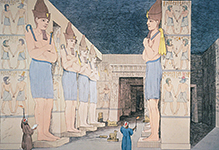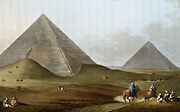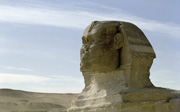
Egypt
Birth and Death,Cult and Gods,Pharaos and Officials,Pyramids and Temples,Daily Life.

#03010249
Coptic textile (linen and wool) showing a nilometer. Nereids and putti are depi...

#03010265
Interior of the ruins of the temple at Karnak,Egypt. 1822

#03010266
"Principal Square in Grand Cairo, with Murad Bey's Palace",Egypt, around 1801. A...

#03010267
"An Arabian Summer House upon antique fragments on the Canal of Menouf",Egypt, a...

#03010268
The obelisk at Alexandria, called "Cleopatra's Needle", Egypt, around 1801. Fro...

#03010269
"First and second pyramid of Gizah, Ancient Memphis", Egypt, around 1801. A view...

#03010270
"Head of the colossal sphinx", Egypt, around 1801. From "Views in Egypt, Palest...

#03030235
Statue of Nofret wearing a wig and bead necklace (detail). Painted limestone st...

#03030236
Satue of Pharaoh Mycerinos (2485-2457 BCE, aka Mykerinus, Menkaura). Alabaster s...

#03030237
Relief of a harvest scene from the mastaba of Ipi. Saqqara, Egypt; Old Kingdom...

#03030238
The Doctor. Wodden statue from Saqqara, Egypt. Old Kingdom (5th dynasty).

#03030239
The Royal Scribe. Painted limestone sculpture; Saqqara, Egypt. Old Kingdom , 5...

